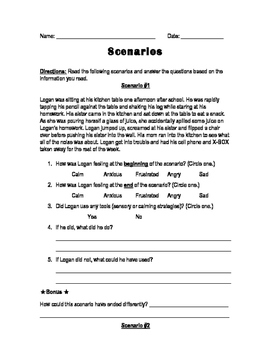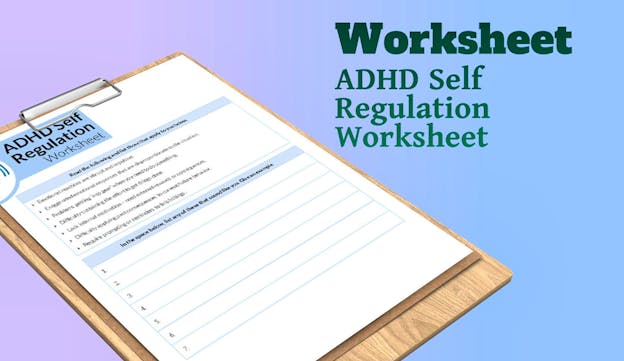Self Regulation Worksheet : What it is
Self Regulation Worksheet: What It Is and How It Can Help
Are you struggling with self-regulation? Do you find it difficult to manage your emotions and behavior in different situations? If so, you're not alone. Many people struggle with self-regulation, and it can have a significant impact on their daily lives. But don't worry, there is a solution - a self-regulation worksheet!
A self-regulation worksheet is a powerful tool that can help you develop and enhance your ability to regulate your emotions and behavior. It provides you with a structured approach to identifying and understanding your triggers, exploring alternative responses, and ultimately gaining control over your reactions. In this post, we will explore the benefits of using a self-regulation worksheet and how it can help you improve various aspects of your life.
Benefits of Using a Self-Regulation Worksheet

A self-regulation worksheet can offer numerous advantages for individuals looking to improve their self-regulation skills. Here are some of the key benefits:
- Self-awareness: A self-regulation worksheet helps you become more aware of your emotions, triggers, and how they affect your behavior. By identifying patterns and triggers, you can develop strategies to manage them effectively.
- Emotional control: Through a self-regulation worksheet, you can learn to regulate your emotions and avoid impulsive reactions. It provides you with a framework to pause, reflect, and choose a more appropriate response.
- Improved relationships: By enhancing your self-regulation skills, you can build healthier and more fulfilling relationships. You'll be able to communicate more effectively, handle conflicts with grace, and become a better listener.
How to Use a Self-Regulation Worksheet
Using a self-regulation worksheet is straightforward and can be done in a few simple steps:
- Identify your triggers: The first step is to identify what triggers your emotional responses. It could be certain situations, people, or even thoughts. Write down your triggers in the worksheet to gain clarity.
- Recognize your emotions: Once you've identified your triggers, pay attention to the emotions that arise in those situations. Are you feeling angry, sad, or anxious? Understanding your emotions better can help you respond more appropriately.
- Explore alternative responses: After recognizing your emotions, brainstorm alternative responses that align with your goals and values. Consider how you can replace impulsive reactions with more constructive actions.
- Practice, practice, practice: Changing your responses and developing self-regulation skills takes time and practice. Use the worksheet to track your progress and make adjustments as needed.
Frequently Asked Questions
Here are some common questions about using self-regulation worksheets:
- 1. Who can benefit from using a self-regulation worksheet?
- Anyone who wants to improve their self-regulation skills can benefit from using a self-regulation worksheet. It is particularly helpful for individuals with ADHD, autism, or other conditions that affect self-regulation.
- 2. Can I use a self-regulation worksheet on my own?
- Absolutely! Self-regulation worksheets are designed to be used independently. However, if you feel that you need additional support, consider working with a therapist or counselor specialized in self-regulation.
- 3. How often should I use a self-regulation worksheet?
- There is no one-size-fits-all answer to this question. It depends on your needs and preferences. Some people benefit from using a self-regulation worksheet daily, while others may find weekly or bi-weekly sessions more effective.
In conclusion, a self-regulation worksheet can be a game-changer for individuals struggling with self-regulation. It provides a structured approach to developing self-awareness, enhancing emotional control, and improving relationships. By utilizing a self-regulation worksheet, you can gain control over your emotions and behavior, leading to a happier and more fulfilling life.
30 Social Emotional Learning Self-Regulation Breaks Mindfulness
 Image Source : www.pinterest.com.au
Image Source : www.pinterest.com.au Pin On Child Development
 Image Source : www.pinterest.ph
Image Source : www.pinterest.ph Emotion Identification Worksheets
 Image Source : aliceworksheet99.z21.web.core.windows.net
Image Source : aliceworksheet99.z21.web.core.windows.net Self Regulation Scenarios By The OT Specialist | TpT
 Image Source : www.teacherspayteachers.com
Image Source : www.teacherspayteachers.com self regulation scenarios school zones skills activities worksheets social homework activity making decision choices students consequences special middle high teacherspayteachers
Emotion Regulation Skills Please Worksheet Psychpoint - Emotional
 Image Source : akirahendicks.blogspot.com
Image Source : akirahendicks.blogspot.com PLR Worksheets - ADHD Self Regulation Worksheet - PLR.me
 Image Source : www.plr.me
Image Source : www.plr.me adhd regulation self plr worksheet worksheets
PsychCreatives | Self-Regulation Adult Handout
 Image Source : www.psychcreatives.com
Image Source : www.psychcreatives.com regulation handout worksheets coping counseling dbt discipline behavior yourtherapysource situations zones calming conscious joyspring
Self Regulation In The Classroom Worksheets
regulation self classroom skills worksheets worksheetplace activities behavior kids preschool depends success great work sheet where school
30 social emotional learning self-regulation breaks mindfulness. Self regulation in the classroom worksheets. Emotion regulation skills please worksheet psychpoint. Adhd regulation self plr worksheet worksheets. Regulation handout worksheets coping counseling dbt discipline behavior yourtherapysource situations zones calming conscious joyspring